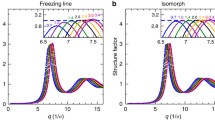Abstract
It is shown that under realistic conditions the processes of crystallization of complex systems can be described using effective rate functions. Being a thermodynamic stimulant of the process, these functions enter as a composite factor in all equations for the crystallization redistribution of the composition and in the equations for the rate of motion of the liquid zone in the zone-melting method with a temperature gradient. The values of the crystal growth rates achieved are described using these functions. To supplement the results of the theory of concentration supercooling, estimates are obtained of the limiting rates of temperature drop in liquid epitaxy using Nelson's method of forced cooling. The result obtained is found to be in agreement with published experimental data.
Similar content being viewed by others
Literature cited
W. G. Pfann, Zone Melting, 2nd ed., Wiley-Interscience (1966).
V. N. Romanenko. Production of Uniform Semiconducting Crystals [in Russian], Metallurgiya, Moscow (1966).
B. Chalmers, Theory of Solidification [in Russian], Metallurgiya, Moscow (1969).
G. V. Nikitina and V. N. Romanenko, Teor. Osn. Khim. Tekhnol., No. 6, 839 (1970).
V. N. Romanenko, V. S. Lukash, and V. S. Kheifets, Teor. Osn. Khim. Tekhnol., No. 5 (1975).
V. N. Vigdorovich, K. M. Rozin, and A. N. Krestovnikov, Zh. Fiz. Khim.,35, No. 8, 1752 (1961).
D. A. Petrov, Zh. Fiz. Khim.,21, No. 12, 1449 (1947).
V. N. Lozovskii, Zone Melting with Temperature Gradient [in Russian], Metallurgiya, Moscow (1972).
G. S. Konstantinova, “Crystallization and the properties of crystals,” Tr. Novocherk. Politekh. Inst.,239, 3 (1971).
L. S. Darken, Trans. Metall. Soc. AIME,175, No. 12, 184 (1948).
W. A. Tiller, J. Rutter, K. Jackson, and B. Chalmers, Acta Metall.,1, 428 (1953).
G. V. Nikitina, K. V. Ostanina, V. N. Romanenko, and V. S. Kheifets, in: Theses of Reports to the Third Symposium on the Processes of Growth and Synthesis of Semiconducting Crystals and Films [in Russian], Izd. Sib. Otd. Akad. Nauk SSSR, Novosibirsk (1972), p. 28.
Yu. B. Bolkhovityanov, R. N. Bolkhovityanova, and P. L. Mel'nikov, Izv. Akad. Nauk SSSR, Neorg. Mater.,9, 320 (1973).
Additional information
Translated from Izvestiya Vysshikh Uchebnykh Zavedenii, Fizika, No. 1, pp. 106–111, January, 1978
Rights and permissions
About this article
Cite this article
Romanenko, V.N., Lukash, V.S., Nikitina, G.V. et al. Thermodynamic characteristics of phase-transition intensity in describing crystallization processes. Soviet Physics Journal 21, 89–94 (1978). https://doi.org/10.1007/BF00896303
Received:
Issue Date:
DOI: https://doi.org/10.1007/BF00896303



